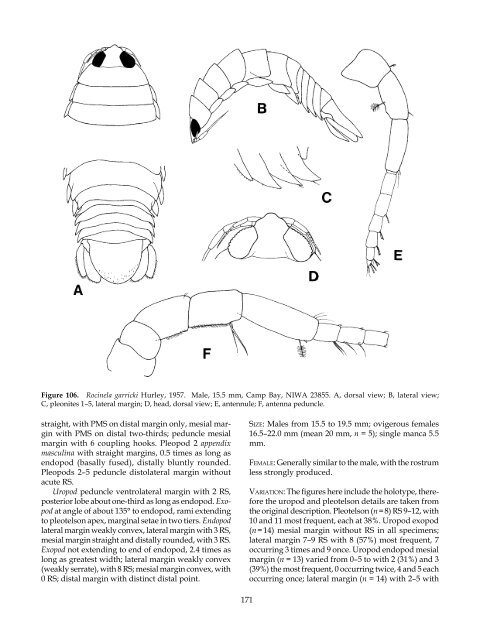The Marine Fauna of New Zealand: Isopoda, Aegidae (Crustacea)
The Marine Fauna of New Zealand: Isopoda, Aegidae (Crustacea)
The Marine Fauna of New Zealand: Isopoda, Aegidae (Crustacea)
You also want an ePaper? Increase the reach of your titles
YUMPU automatically turns print PDFs into web optimized ePapers that Google loves.
Figure 106. Rocinela garricki Hurley, 957. Male, 5.5 mm, Camp Bay, NIWA 23855. A, dorsal view; B, lateral view;<br />
C, pleonites –5, lateral margin; D, head, dorsal view; E, antennule; F, antenna peduncle.<br />
straight, with PMS on distal margin only, mesial margin<br />
with PMS on distal two-thirds; peduncle mesial<br />
margin with 6 coupling hooks. Pleopod 2 appendix<br />
masculina with straight margins, 0.5 times as long as<br />
endopod (basally fused), distally bluntly rounded.<br />
Pleopods 2–5 peduncle distolateral margin without<br />
acute RS.<br />
Uropod peduncle ventrolateral margin with 2 RS,<br />
posterior lobe about one-third as long as endopod. Exopod<br />
at angle <strong>of</strong> about 35° to endopod, rami extending<br />
to pleotelson apex, marginal setae in two tiers. Endopod<br />
lateral margin weakly convex, lateral margin with 3 RS,<br />
mesial margin straight and distally rounded, with 3 RS.<br />
Exopod not extending to end <strong>of</strong> endopod, 2.4 times as<br />
long as greatest width; lateral margin weakly convex<br />
(weakly serrate), with 8 RS; mesial margin convex, with<br />
0 RS; distal margin with distinct distal point.<br />
7<br />
size: Males from 5.5 to 9.5 mm; ovigerous females<br />
6.5–22.0 mm (mean 20 mm, n = 5); single manca 5.5<br />
mm.<br />
femaLe: Generally similar to the male, with the rostrum<br />
less strongly produced.<br />
Variation: <strong>The</strong> figures here include the holotype, therefore<br />
the uropod and pleotelson details are taken from<br />
the original description. Pleotelson (n = 8) RS 9– 2, with<br />
0 and most frequent, each at 38%. Uropod exopod<br />
(n = 4) mesial margin without RS in all specimens;<br />
lateral margin 7–9 RS with 8 (57%) most frequent, 7<br />
occurring 3 times and 9 once. Uropod endopod mesial<br />
margin (n = 3) varied from 0–5 to with 2 (3 %) and 3<br />
(39%) the most frequent, 0 occurring twice, 4 and 5 each<br />
occurring once; lateral margin (n = 4) with 2–5 with

















